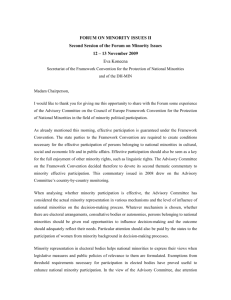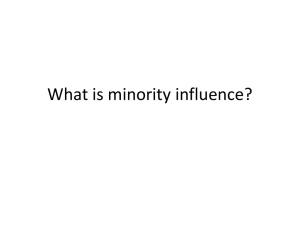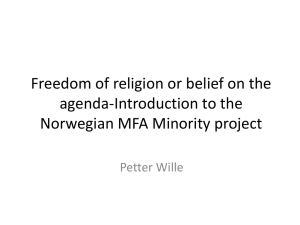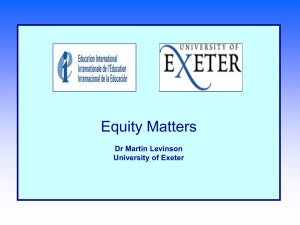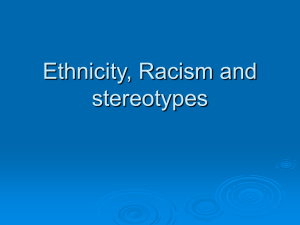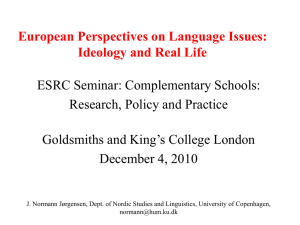Model answer 2
advertisement
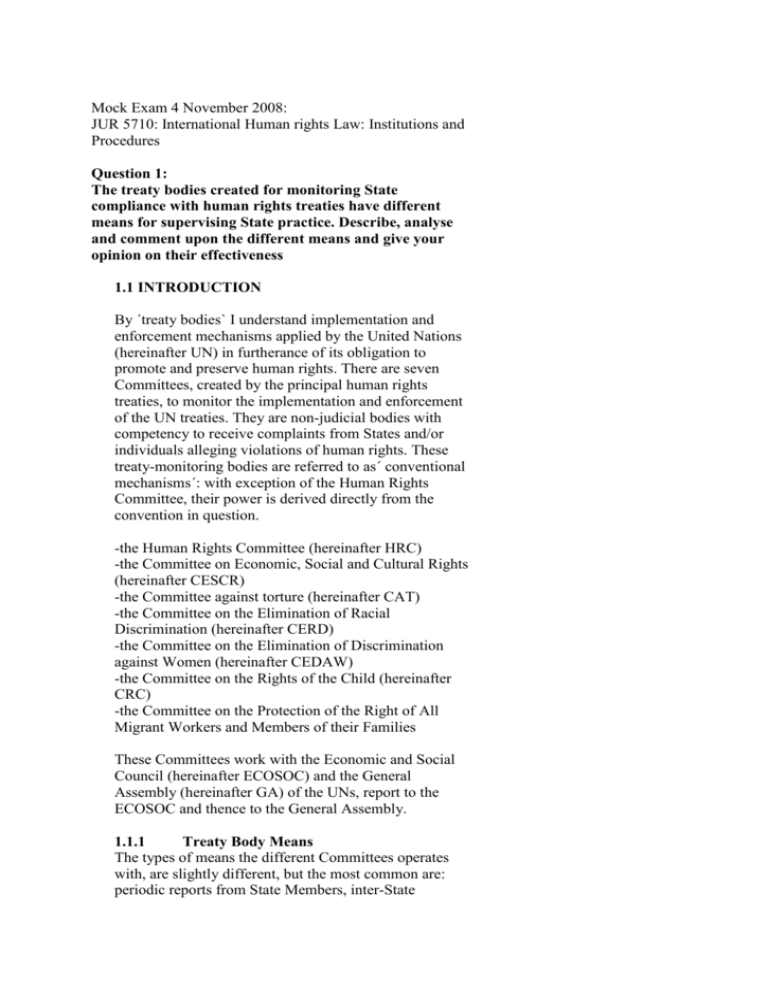
Mock Exam 4 November 2008: JUR 5710: International Human rights Law: Institutions and Procedures Question 1: The treaty bodies created for monitoring State compliance with human rights treaties have different means for supervising State practice. Describe, analyse and comment upon the different means and give your opinion on their effectiveness 1.1 INTRODUCTION By ´treaty bodies` I understand implementation and enforcement mechanisms applied by the United Nations (hereinafter UN) in furtherance of its obligation to promote and preserve human rights. There are seven Committees, created by the principal human rights treaties, to monitor the implementation and enforcement of the UN treaties. They are non-judicial bodies with competency to receive complaints from States and/or individuals alleging violations of human rights. These treaty-monitoring bodies are referred to as´ conventional mechanisms´: with exception of the Human Rights Committee, their power is derived directly from the convention in question. -the Human Rights Committee (hereinafter HRC) -the Committee on Economic, Social and Cultural Rights (hereinafter CESCR) -the Committee against torture (hereinafter CAT) -the Committee on the Elimination of Racial Discrimination (hereinafter CERD) -the Committee on the Elimination of Discrimination against Women (hereinafter CEDAW) -the Committee on the Rights of the Child (hereinafter CRC) -the Committee on the Protection of the Right of All Migrant Workers and Members of their Families These Committees work with the Economic and Social Council (hereinafter ECOSOC) and the General Assembly (hereinafter GA) of the UNs, report to the ECOSOC and thence to the General Assembly. 1.1.1 Treaty Body Means The types of means the different Committees operates with, are slightly different, but the most common are: periodic reports from State Members, inter-State petitions, individual petitions, investigations and General Comments. There is interference and cooperation between the different treaty monitoring bodies to a wide extent. The different Committees can study each other’s reports and observations. With regard to petitions or complaints, the full details for admissibility will be found in the rules of procedure for the Committee in question. In general, once a complaint is found admissible, the State against whom the complaint is made will be asked to submit its observations in response. The Committee will then consider the complaint and the observations, possibly in dialogue with the State(s) concerned. After consideration of the merits, a report will be issued containing the conclusions and opinion of the Committee. In the following, the different means for supervising State practice belonging to each Committee will be briefly examined. Thereinafter, the effectiveness of the main means will be discussed. -the Human Rights Committee/HRC: Consists of eighteen members (Art. 28(2) of the ICCPR) who meets thrice a year. The HRC has compentency to receive periodic reports, to receive inter State complaints (Art. 41) and, under the first Optional Protocol, to receive individual petitions. It remains disputed whether the Human Rights Committee's in principle non-binding final views (´Concluding Observations´) qualify as decisions of a quasi-judicial body or simply constitute authoritative interpretations on the merits of the cases brought before them for the members of the Optional Protocol of the Covenant on Civil and Political Rights. Contracting parties are bound to submit periodic reports on the measures they have adopted to give effect to the Covenant when requested to do so by the Committee (Art. 40(1)). Initial reports should be submitted within a year of entry into force of the Covenant for the State in point. Over the years, the Committee has adopted a large number of so-called General Comments. General Comments are addressed to State Parties in general and are designed to provide guidance to them in discharging their reporting obligations under the Covenant. -the Committee on Economic, Social and Cultural Rights/CESC: Eighteen members (elected by ECOSOC) who meet twice a year. Initial reports are submitted within one year of the entry into force of the Covenant for the State concerned. Cross references to information submitted to other UN bodies are acceptable. Reports are also filed by specialized agencies with competence in relevant matters. Provision is made for the Committee to visit States for in situ investigations and information gathering. The preparation of an Optional Protocol to the Covenant which will enable the Committee to receive individual complaints is ongoing. -the Committee Against Torture/CAT: consist of ten members who meet twice a year. States Parties must deliver their initial report within 1 year after entry into force and thereafter every forth year. Inter-State complaints may be raised before the committee if both States concerned have recognized the competence of the Committee in this respect under Article 21. Individual complaints may also be raised before the Committee against States which have agreed to the procedure articulated in Article 22. Investigatory powers of the Committee are enshrined in Article 20. -the Committee on the Elimination of Racial Discrimination/CERD: Eighteen members meeting twice a year. Contracting parties deliver periodic reports every two years. The reports are being presented by a representative from the State in question, who also answer questions from the experts. The Convention also provides for compulsory inter-State complaints procedure by which States may arise issues relating to the compliance of other States with the Convention. The optional individual complaint process forms an integral part of the Convention as it is enshrined in Article 14 of the Convention. As a provision to secure the fulfilment of the UN’s objectives in respect of decolonization, CERD also gives opinions and makes recommendations on individual and group petitions from, as well as receive reports from non-self-governing and trust territories (mandatory system). -the Committee on the Elimination of Discrimination Against Women/CEDAW: 23 members who meet for approx. eight working days (no more than 2 weeks) a year. State Parties to the Convention agree to submit periodic reports every four years on the ´legislative, judicial, administrative or other measures which they have adopted´ to give effect to the convention (Art. 18).The Convention also provides that the Committee can make general recommendations and suggestions (Art. 21). An Optional Protocol to the Convention adopted in 1999 provides for individual complaints, but cannot take action. The complaints are being used as information material. This information may help shape future policies. As with the Committee against Torture, the Committee will operate with the State Party in investigating the matter. -the Committee on the Rights of the Child/CRC; States Parties undertake to submit reports every five years to the Committee (Art. 44). Unlike other reporting systems, the Committee on the Rights of the Child requires that governments publish the reports within their jurisdiction and disseminate the observations of the Committee. The approach taken by the Committee is one of consolidation – the Committee views itself as working alongside developing internal State systems for monitoring and realizing children’s rights. The Committee is effectively applying the full myriad of international human rights. Assuming reports are submitted timeously, taking the reports in conjunction with the additional information on each State obtained in pre-sessional meetings from NGOs and specialized agencies allows the Committee to build up what should be a full and accurate picture of the human rights situation in almost every Member State of the UN. Two parallel chambers with nine members in each which meet three weeks three times a year (one week pre-sessional working groups) as an ´exceptional and temporary measure due to heavy back load´. The most widely accepted of all UN treaties. -the Committee on the Protection of the Right of All Migrant Workers and Members of their Families: Ten expert members (Art. 72) (rising to thirty should fortyone States ratify). The first meeting was held in March 2004. States should submit reports every five years (Art. 73). An optional system of inter-State complaints and individual communications is envisaged in Arts. 76 and 77, but awaits the necessary declarations. 1.2 EFFECTIVENESS 1.2.1 Conclusions/opinions/General Comments As long as the conclusions or opinions of the different Committees deliver are not legally binding, they do not have the same effect as a court decision. If the States can chose whether to comply with them or not and the only consequence of not complying is bad reputation, it might not be followed in practice. Many states will let other factors, e.g. financial - , decide whether to change the situation or not. This is definitely undermining the human rights system and weakening its effects. On the other hand, many states are much more reluctant to sign and ratify the treaties/optional protocols in question if the conclusions are legally binding. Thus, a system, based on the good-will of the Member States, to some extent, may be more effective than one with legally binding decisions. The ´jurisprudence´ of the different Committees (their interpretation of the obligations of the States under the respective treaties) contributes to a uniform interpretation amongst the State Members. This is an important aspect, which clearly make the system more effective. The same applies for the General Comments. 1.2.2 Reports The main problem concerning the efficiency of reports a means, is that they, to a wide extent, are overdue. According to Petter F. Wille (Ambassador, Permanent Mission of Norway to the Council of Europe), some States do not even submit initial reports. In this regard, the reporting system is not very effective. Another side of this is that if all States did follow the procedures punctually, the consequence would be heavy back loads, as the monitoring bodies often do not have sufficient capacity to handle all of them (ref. P. Wille). One measure which can be used to make States Members submit their reports in timely manner (or to benefit on the situation if they do not), is the report procedures adopted by the ESCR: When problems with overdue reports are experienced, it is the habit of the Committee, after due notice to the State Party concerned, to consider the economic, social and cultural rights in the State on the basis of all the information available to them. This is inevitably a good opportunity for NGOs to form debate. The practice of considering human rights in any given State in the absence of an overdue report is gaining ground in international and regional organizations. Some states will attend sessions to defend against any circumstantial or uncorroborated evidence on their human rights situation. This allows the Committee to obtain a more balanced viewpoint. When reports are being published within the State; as is required for reports to the Committee on the Rights of the Child, the system becomes transparent. Transparency in this regard, will most likely stimulate the State Members to work hard for compliance with the Convention. It may also create ´synergy effects´; since transparency makes the State population more aware of children’s rights and in that way may enhance the interest for children’s rights. An increasing interest and awareness may result in a demand for higher compliance and, eventually, also consensus on this. In order to assist States in realizing the goals specified in the treaties, the monitoring bodies may bring to the attention of other organs of the UN, subsidiary organs and specialized agencies concerned with furnishing technical assistance any matters arising out of the reports This enables such bodies to decide on the advisability of international measures which may contribute towards the effective progressive implementation of the Covenant (see e.g. Art. 22 of the ICESR). Cross references to information submitted to other UN bodies contributes to transparency and cooperation; which again contributes to efficiency. 1.2.3 Efficiency of other means Whilst some of the Committees function rather ineffectively, others function almost ideally. The best functioning Committee seems to be the CRC. Knowing this, maybe it would be worth considering implementing some of the CRC’s working methods in other Committees? The ´comprehensive approach´ adopted by the Committee on the Rights of the Child is to be encouraged according to para. 89 of the Vienna Declaration and Programme of Action. It is not difficult to imagine that States receiving this kind of ´personal service´ will be inspired to, as well as feel obliged to, strive for a much higher degree of compliance with the Convention than if they did not receive such. Moreover, it is undoubtedly much easier for the States to develop internal State systems to monitor and realize human rights if they are supported in this way. Furthermore, it is evident that a Committee which consists of only a few members who meet no more than a week or so a year must have very limited resources to deal with the reports and petitions they receive. This may also create heavy back loads of cases. Taken the nature of the cases, it should be an aim in itself to achieve expeditious, though thorough, processes regarding case handling in all Committees. This is inevitably dependent on increased resources, but it is possible that much could be done only by changing some of the established processes. Two parallel chambers do, for instance, handle twice as many cases as one. With this in mind, it remains to hope that the CRC will continue to work with a twochamber system not only for a limited time, and that it will also be investigated what could be done in other Committees; in order to obtain a higher degree of efficacy. Diplomatic´ statements made by the Committees in reports as well as in conclusions, to point out areas of concern without offending the State Members may also be frustrating. One could definitely wish for some more ´back bone´ from the Committees’ sides from time to time. On the other hand, knowing that strong comments or requirements may result in reservations, as well as withdrawals by the State Members (ref. case against Trinidad regarding death penalty; which finally caused Trinidad’s withdrawal from the Convention), ´Diplomatic´ statements may, hence, be preferable. 1.3 CONCLUSION As Rhona Smith put it: There are inevitably limitations to the jurisdiction of the Committees and the jurisprudence produced by them is incomparable to that of regional human rights courts such as the European Court of Human Rights. Nevertheless, the importance of the Committees should not be underestimated. To use a cliché: ´Everything is better than nothing´. At the very least we are moving in the right direction. Question 2: The protection of the rights of minorities and their members has a long history in international law. Describe, analyze and comment upon the development of the protection of minorities within universal and regional systems. Take into consideration both institutional and substantive elements of these developments. 2.1 INTRODUCTION/DEFINITIONS Minority rights provide groups of individuals who are a minority in a State with certain rights enforceable against the State exercising power over them. Special rights for minority groups can be defined as the requirement to ensure suitable means, including differential treatment for the preservation of minority characteristics and traditions which distinguish them from the majority of the population. One of the main problems associated with minority protection under international human rights law, has been the lack of a universally accepted definition of what constitutes a minority. Similar problems have been experienced in defining the ´peoples´ to whom the right to Self-determination (Art. 27 in ICCPR) ascribes. The special Rapporteur on Prevention of Discrimination and Protection of Minorities, F. Capoporti’s definition in application of Article 27 ICCPR (1979): ´A group numerically inferior to the rest of the population of a State, in a non-dominnat position, whose members – being nationals of the State – posses ethnic, religious or linguistic characteristics differing from the rest of the population and show, if only implicitly, a sense of solidarity directed towards preserving their culture, traditions, religion or language´. The basis for legal protection of the rights of persons belonging to ethnic, national, religious and linguistic minorities can be divided into four justifications: -International human rights law -international criminal law -maintenance of peace and stability -the protection of world cultural heritage Indigenous peoples are one type of minorities, but not all minorities are indigenous. Nor does it exist any generally accepted definition for ´indigenous´. There a subjective, as well as objective elements which need to be taken into consideration. Self-identification as indigenous is a fundamental criterion. Supplementing objective criteria, such as history, relation to land, currently marginalization, etc. are other elements which come into play. Developments, especially with regard to the question of self-determination, demonstrate that clear cuts distinctions between the three categories (Peoples, minorities, indigenous peoples) are not possible. In most cases practice allows us to identify the type of group, but political interests have prevailed in maintaining grey areas between the different categories. As it implies numerous obligations, States are, in general, reluctant to characterize groups within their jurisdiction as ´minorities´ or ´peoples´. Provisions for minority rights can be found in a number of universal instruments: -Art. 15 ICESCR -Art. 13 (c) CEDAW – Art. 5 (e) ICERD -Art. 31 CRC -UNESCO Convention for the Protection of the Diversity of Cultural Expressions (2005) -UNESCO Convention on the protection of the Diversity of Cultural Expressions (2005) -Art. 27 ICCPR -Art. 30 CRC -ILO Convention concerning Indigenous and Tribal peoples in Independent Countries (1989) -Art. 27 UDHR -UN Declaration of the Rights of Indigenous Peoples (2007) (The list is not exhaustive.) The most essential of these provisions will be investigated in the following. However, first a brief overview of the history of minority rights will be given. 2.2 HISTORY There are two principal schools of thought on minority treatment: assimilation and recognition (or fusion). The former entails the integration of minority groups into the life and the culture of the majority of the population, whilst the latter entails the recognition and promotion of minority groups. The history of minority protection can in many ways be seen as a path from the former to the latter. 2.2.2 Pre World War I Minority rights have a long history. The idea of a specific body of law to protect minorities found favour in nineteenth century Europe, home to a large number of ethnic, religious and linguistic groups. Minority protection before the two Great World Wars may be linked to the contemporaneous rise of nationalism. Individuals began to appreciate the uniqueness of their national, cultural and social identity. Accordingly, national groups developed individual concepts of nationality based on their unique traits. However, through time, these identifying characteristics formed the basis of distinction between ethnic groupings in the State. These groups which possessed different characteristics from the majority of the population came to be regarded as ´minorities´ and were, in general, proud of their distinctive cultural heritage. Attempts by States to impose an artificial uniform nationality upon all groups (irrespective of their cultural and ethnic origins) in a territory, proved ultimately unsuccessful. Nationalism became a major factor in European politics escalating the deterioration of the national order, which culminated in the outbreak of the First World War. 2.2.3 Inter-war situation/the League of Nations Redrawing of the political map in Europe after the First World War initiated a new era for minority rights. In the main, the object was political, not humanitarian. The main object for minority protection in the peace treaties was to avoid the many inter-State frictions that had occurred as a result of the frequent ill treatment of national minorities. The rationale was sound: national minorities could not disturb international peace and security if their national problems were resolvable in an established international forum (the League of Nations) and thus neighbouring states did not require to resort to covert or open hostilities in defence of a minority group. The League of Nations played an important role in developing an international system for the protection of minorities. Protection of minorities was stipulated as a precondition for membership in the League itself. However, the subject was not regulated by the Covenant of the League of Nations (1920). Instead, the League derived its powers in this field from a series of treaties concluded after World War I. The first treaty to establish this protective regime was the Treaty between the Principle Allied and Associated Powers and Poland, signed at Versailles on June 29, 1919. It served as a model for the other treaties. The League of Nations agreed to serve as guarantor of the obligations the parties assumed in these treaties. It exercised that function by developing a system for dealing with petitions by minorities charging violations of their rights. Protection of minority groups under the auspices of the League of Nations – was twofold: guarantees embodied in mandates/trust territory treaties and guarantees imposed on States in the peace Treaties. In entrusting the League with the protection of minorities in the new Europe, a special clause was inserted in the Peace Treaties. Such clauses were the basis of the minority system in the League of Nations and the foundation of the subsequent special minority protection treaties drawn up at the Peace conference later. The special minority chapters in these Peace treaties contained what became known as the ´guarantee clause´. In each instance, identical terms were used. The League of Nations had only limited success enforcing the minority guarantee clauses. Although some isolated minorities arrangements of the League era survive to this day, the League’s minority system as such died with it. 2.2.4 The International Labour organization (ILO) The ILO was the first international organization on which individuals were represented. In the last eighty years, the ILO has continued to set standards and supervise the application thereof throughout member States. The League of Nations Covenant envisaged the establishment of an international organization to promote ´fair and humane conditions of labour for men, women and children.´ That function was assumed by the International Labour Organization, which came into being at about the same time as the League. The ILO also provides protections for vulnerable groups, including indigenous and tribal peoples. Of special interest in regard to minority rights, is the ILO Convention concerning Indigenous and Tribal Peoplas in Independent Countries of 1989; which replaced the Convention No. 107. The ILO survived the League and is now one of the Specialized Agencies of the UN. 2.2.5 After the Second World War/the United Nations In the years following the two Great Wars, national homogeneity was the declared aim, chaos the result. The original humanitarian principles were often sidestepped and even deliberately ignored. Minorities and their treatment became a matter for bilateral negotiation, not general international concern. The tumultuous problems experienced in Europe at this time prompted the new world order to ´change tack´: Minority and sectoral protection was replaced by a concerted global attempt to secure basic rights for all, without distinction. Before the foundation of the United Nations, the human rights protection which existed was rather sporadic. The event of a truly global community created in the shadow of mass violations of human rights and serious infringements of territorial sovereignty with ensuing catastrophic suffering provided an appropriate platform for the launch of contemporary human rights. The United Nations decided that the system of minority group protection advocated by the League of Nations had outlived its political expediency and elected to pursue a policy of universal human rights, rendering a separate system for minority protection superfluous. The establishment of the Sub-Commission on the Prevention of Discrimination and the Protection of Minorities maintained a profile for relevant issues (now the SubCommission on the Protection and Promotion of human Rights). 2.3 PROVISIONS 2.3.1 UDHR, Article 27 Equal rights and non-discrimination are the basic principles in UDHR, the International Covenants and other human rights instruments. Art. 27 of the UDHR restricted itself to establishing a ´right to freely participate in the cultural life of the community´ despite detailed debates on the issue. It is a cultural right for the community. No specific rights for minorities were hence given (ref. ´all´ in Art. 27.) It can be argued that the UDHR covered minority rights insofar as many minority issues are included expressly or implicitly; e.g. freedom of expression (Art. 19) and freedom of religion (Art. 18). However, the provisions of the UDHR proved incapable of being used to protect minority groups in the manner they desired. Accordingly, the provision (Art. 27) was included in the ICCPR. 2.3.2 ICCPR, Article 27 Art. 27 of the International Covenant on Civil and Political Rights 1966 is the most well-known provision on special rights for minorities. It is widely recognized as a real attempt in international law to promulgate the right of minority groups to preserve their special identity. The drafters considered the omission of such a provision in existing legislation a gap in the sequence of internationally recognized human rights (Nowak, M). Even though it has collective aspects, Article 27 is, contrary to Article 1 of the same Covenant (the Right to Self-determination); which is a collective right, an individual right. 2.3.2.1 ´Exist´ Art. 27 of the ICCPR is limited only to those States in which ethnic, religious or linguistic´ groups are to be found (ref. ´exist´). Capotorti, suggests that it is the responsibility of each to recognize the existence of a minority group. Nevertheless, if a State fails to do so, a group whose members can be distinguished from the majority population by one or more of the stipulated characteristics is entitled to rely on the Article. This line of reasoning (inclusion on the basis of objective criteria) was used in Lovelace v. Canada. The author of the communication, Sandra Lovelace, was born and registered a Maliseet Indian, but lost her rights and status as an Indian (in accordance with domestic law) when she married a non-Indian. Mrs. Lovelace subsequently divorced and sought to return permanently to the reserve. As she remains ethnically a Maliseet Indian, the Committee opined that she could still be regarded as belonging to the minority group and thus invoke the rights which should accrue to her in terms of Article 27. Capotorti refutes the idea that inclusion in Article 27 is dependent on the good-will of States, arguing instead for inclusion on the basis of objective criteria. The term ´minorities´ was abandoned in favour of the phraseology ´persons belonging to´ minorities to ensure legal acceptance: minorities per se were not subjects of international law, persons belonging to such groups however, could be defined. The necessity for a group identity of a minority was reinforced by the inclusion of ´in community with other members of their group´. Group membership is thus a sine qua non of the enjoyment of the rights. The selection of ethnic, religious and linguistic is significant, as it is a narrower confine than that enshrined in non-discrimination instruments. In effect, by concentrating on these groups, the Covenant reiterates the criteria employed by the League of Nations in determining whether a group could be termed a minority and thus afford the necessary protection. It is arguable that ´racial´ and ´ethnic´ are interchangeable. (´National´ remains the preferred terminology in Europe.) The provisions apply in addition to those contained elsewhere in the Covenant. Thus, the minorities to whom the Covenant extends are afforded the benefit of an extra right, a degree of specialist protection. No limitations on this right were incorporated into the text. Minority rights apply irrespective of the permanence of any given group in a State. Similarly, State recognition of the minority in question is not required. 2.3.2.2 The right to enjoy one’s culture The lack of a concise definition of the term ´culture´ is a main stumbling block in this area of international law. In a UNESCO report, ´culture´ has been defined as ´inextricably linked to tradition´. As culture, then, comprehends all that is inherited or transmitted through society, it follows that it is individual elements are proportionately diverse. ´Culture´ is a complex concept. It embraces all aspects of life in a community. It has individual as well as collective aspects. Any test of a State’s compliance with Art. 27 will, by its very nature, be objective. Positive or negative promotion of the culture by the State will be a key issue. Essentially, what is required is proof that a community’s culture is not suffering from State oppression. The Human Rights Committee has acknowledged that Art. 27 allows for the ´adaptation of those (traditional) means to the modern way of life and ensuing technology´. In Lovelace v. Canada, the Committee stated that the major loss to a person ceasing to be an Indian is the loss of the cultural benefits of living in an Indian community and that a refusal of Canadian law to permit the realization of this natural cultural attachment was a breach of Article 27. The case of Lovelace can be contrasted to that of the Lubicon Lake Band a few years later when the Committee appeared more willing to recognize the rights of indigenous groups without reservations. 2.3.2.3 The right to profess and practice religion A principal problem in the guarantee by a State of freedom of religion, particularly for minority religions, is the historical interaction between a State and its religion. Many States have an accepted State religion from which holidays and the laws governing, for example, marriage and dissolution evolve. Consequently, even a formal de jure separation between the State and religion does not guarantee true, de facto, separation. Religious beliefs influence too many aspects of life to be ignored. Perhaps more than culture, religious freedom, by its nature, involves acts in community with others. Once again, any test of a State’s compliance with art. 27 in this respect will tend towards a objectivity. To an extent, the provisions of art. 27 overlap with those of art. 18 (freedom of religion). There is also an inevitable overlap with Art. 26; concerning State funding of secular schools. 2.3.2.4 The right to use one’s own language Minority languages may simply be languages spoken by deemed minority groups or languages other than the principle language of State. There is no universal consensus on the scope of ´language´. Ideally, each language and the approach of the State thereto should be resolved on a pragmatic basis. Full and natural use of language is complex. Cases brought against France arguing preservation of minority languages have been inadmissible under Art. 27 as France entered a reservation upon ratification which rendered Art.27 inapplicable (see inter alia T.K. & M.K. v. France). 2.3.2.5 Using the International Covenant Art. 27 heralds progress for minority groups resident in the territory of contracting States. However, the realization of the rights enshrined therein are often more idealistic than factual, being dependent on the will of the State. Primarily, a State can restrict the operation of the Article by imposing limitations on the concept of ´minority´. The rights of minorities encapsulated in Art. 27 are not absolute. Derogations are permissible in terms of Art. 4. At no time during the term of derogation, may a State adopt measures or practices that involve discrimination \on the ground of race, colour, sex, language, religion or social origin´. However, Art. 5 provides that nothing in the present Covenant may be interpreted as implying for any State, group or person any right to engage in any activity or perform any act aimed at the destruction of any of the rights and freedoms recognized in the Covenant. According to Capotorti, mere recognition and noninterference in the enjoyment of minority rights is not enough; the States Parties need to take positive measures to ensure that the rights can be enjoyed. Supportive action is required. As a result of the decisions by the Human Rights committee in the Lubicon Lake Band case and the Kitok case, it is clear that Art. 27 does, to some extent protect economic rights; ´if they are an essential element of the culture of an ethnic community´ (Kitok case). Also Article 15 in ICESCR is important regarding minorities’ right to economic development and ability to sustain. 2.3.3 The Decalration on the Rights of Persons Belonging to National or Ethnic, Religious, and Linguistic Minorities 1992 Ethnic tensions in, inter alia Europe, prompted the UN to adopt the Decalration on the Rights of Persons Belonging to National or Ethnic, Religious, and Linguistic Minorities in 1992 . The Declaration owes its existence to the inspiration provided by Article 27 of the International Covenant and the aims at promoting peace and stability. The individual complaints procedures under the CERD may also be of relevance for minorities as may the procedure established by ILO and UNESCO to deal with complaints within their respective areas. 2.3.4 GA Resolution 2007: Declaration on the Rights of Indigenous Peoples The Declaration on the Rights of Indigenous Peoples is a non-binding, aspirational document of the developing standards relating to indigenous peoples in international law - the text creates no new rights in international law. It affirms the equality of the more than 370 million indigenous peoples and their right to maintain their own institutions, cultures and spiritual traditions. It also establishes standards to combat discrimination and marginalization and eliminate human rights violations against them. Although nothing new (or binding) is the subject of the United Nations General Assembly Resolution, it nonetheless is significant as it provides a framework for human rights based dialogue between Indigenous peoples and states. It is possible that eventually the Declaration would have some effect in law – if those rights contained in the declaration were used by enough states that they became elevated to the level of customary law or indeed if the declaration became a convention in which signatory states become legally bound by the instrument. It can be said that some articles (not the whole text) in the DRIP contribute to a growing body of customary law of indigenous peoples rights. Through its adoption, the UN human rights system confirmed that it is indeed capable of faithfully facilitating substantive standard setting activities for the self-determination and collective rights of indigenous peoples. DRIP symbolises goodwill on the part of states in acknowledging the historical and still on-going injustice towards indigenous peoples. The Declaration will also go some way to delivering justice to those first peoples whose deprivation of human rights is the very cornerstone of sovereignty, wealth and power for the most obstructive and argumentative states who voted against the declaration in the General Assembly. The right to self-determination – ICCPR Article 1 Collective or group aspects of minority rights have been strengthened by linking interpretation of art. 27 (and other rights) to Art. 1 of the ICCPR. 2.3.5 This right is of ´particular importance because its realization is an essential condition for the effective guarantee and observance of the individual human rights and for the promotion and strengthening of those rights´ (General Comment No. 12 (1984), para. 1) The right of ´all peoples´ to self-determination has a political dimension (´freely determine their political status´ and pursue their ´economic, social and cultural development´) and also a resource dimension (´shall not be deprived of their own means of subsistence´). 2.4 REGIONAL SYSTEMS 2.4.1 America In the American system, there is a clear link to other rights – Article 16(1) provides for freedom of association for cultural purposes. 2.4.2 Africa The African Charter (Art. 17(2)) provides that every individual may freely take part in cultural life of his community. However, given the emphasis on ´peoples´ in the African Charter, it is inevitable that other ´minority rights´ can easily be inferred in the provisions alluding to cultural and traditional values. Morover, Article 29(7) of the Charter imposes a duty on all individuals to ´preserve and strengthen positive African cultural values´. 2.4.3 Europe Europe, with instruments concluded under the auspices of the various regional organizations, has the most developed system to date. There are no provisions in the European Convention on Human Rights which pertain directly to minorities. The issue of national minorities became increasingly important in the Council of Europe in the 1980s as ethnic conflicts re-emerged in the region. The European Charter for Regional or Minority Languages was a first effort by the Council to afford protection to such groups. Adopted on November 5, 1992 and entered into force March 1, 1998, the Languages Convention is not yet widely ratified. The aims of the agreement are to protect and promote the historical regional or minority languages of Europe and to respect the right to use a regional or minority language in private and public life. On November 10, 1994 the Council of Europe adopted the Framework Convention for the Protection of National Minorities. The title of the Framework Convention indicates its programmatic and largely discretionary nature, a consequence of the political controversy surrounding the issue. Although the instrument is legally binding, the principles contained in it are not directly applicable in domestic law, but require the adoption of national laws and policies by States Parties. The essence of rights is similar to those in the ICCPR: preservation of religion, language, traditions and cultural language, traditions and cultural heritage (Art. 5(1)). It should be noted that the underlying premise is the protection of European heritage to further stability, democratic security and peace in the continent. The European Charter for Regional or Minority Languages is also aimed primarily at national minorities. The object of the Charter is to protect those historical regional or minority languages ´some of which are in danger of eventual extinction which contribute to Europe’s cultural wealth and traditions´ (Preamble). The European Union has not adopted any specific instruments to protect minority rights. However, Article 22 of the European Charter for Fundamental Rights of the European Union states that ´the Union shall respect cultural, religious, and linguistic diversity´. This will govern the operation of all Community institutions in the future. Probably the most significant contribution towards minority rights has been the work of the Organization for security and Cooperation in Europe (hereinafter OSCE). Under the auspices of the OSCE, a system of guidelines has been adopted, but there is no system of implementation or enforcement per se. Although the Helsinki Final Act (1975) makes a passing reference to the rights of individuals belonging to national minorities, it was the Copenhagen Concluding Document that in 1990 proclaimed a series of important OSCE commitments on this subject. In 1992 OSCE established the office of the High Commissioner on National Minorities. With the end of the Cold War, real and potential conflicts posed by minority issues including the armed conflict in the former Yugoslavia, began to threaten the peaceful transition to democracy in Eastern and Central Europe and in the former Soviet Republics. Concern with these problems is reflected in the mandate of the HCNM. 2.5 CONCLUSION It is reasonable to assume that this is one area in which there may be further codifications of the law, perhaps with the adoption of a more binding text on minority rights. The return to minority rights demonstrates that the assumption behind the original post-war documentation (that full recognition of individual rights obviates the need for group and minority protection) was inherently flawed.


